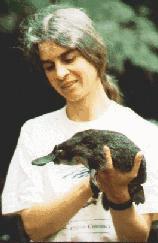Platypus Insights
Courtesy of: The Australian Platypus Conservancy 
Dr Melody Serena, Conservation Biologist with the
Australian Platypus Conservancy, about to return platypus
to the wild after a live-trapping survey.
Hints on spotting platypus Return to Platypus Page
Platypus are most often observed near dawn or dusk, although the animals are also sometimes seen in the middle of the day, particularly along waterways where the animals are relatively abundant.
Males and females are both dark brown in colour, with lighter underparts and a small white spot just in front of the eye. The animals are surprisingly small - approximately 40 to 60 centimetres in length. They float very low in the water, with a slightly higher profile marking the location of their head and rump. When viewed at a distance from the bank, they can bear quite a strong resemblance to a floating stick - and hence are often first recognised by the conspicuous bow wave created as they paddle along the surface.
While platypus sometimes swim strongly in one direction, more often they dive and resurface in a leisurely manner as they feed - generally popping up again within 25 metres of the point where they dived. When foraging, platypus typically remain underwater for less than a minute before returning to the surface to chew their food and sometimes to groom (usually by scratching with a hind foot).
Platypus dives usually create a very distinctive circular ripple pattern. This sometimes has a small number of bubbles in the centre, caused by pockets of air being forced from their double layer of fur.
When alarmed, a platypus will "splash-dive", making a relatively loud single or double splashing noise as the animal dives abruptly. Normal "duck-dives" for food are much quieter, sometimes (but not always) producing an audible "plop".
Australian Water-rats can easily be mistaken for platypus, especially if an animal is seen only briefly. At a distance of more than 20 metres, it can be very difficult to tell the two species apart in the water. The thin, white-tipped tail of the water-rat is the most obvious way to distinguish it from a platypus, which has a flat, paddle-like tail. Water-rats are also much more likely to be seen out of the water (feeding on a rock or log or running along the bank) than platypus are.
Diving ducks (especially musk ducks) and even swimming tortoises can be mistaken for platypus momentarily, but are usually readily distinguished upon longer observation.
Organising a "Platypus Watch" Return to Platypus Page
Platypus are relatively difficult to see in the wild because of their quiet, retiring nature and largely nocturnal habits. Nevertheless, in every catchment there will be a range of people who are in an ideal position to spot the animals, including anglers, canoeists, bushwalkers and farmers working on riverside properties. Such people often do not report platypus sightings simply because they aren't aware of the potential importance of the information and/or don't know whom to contact.
Organising a "Platypus Watch" register of past and present platypus sightings in your local waterway can be an important first step towards harvesting this valuable body of knowledge. People can be encouraged to report their sightings through publicity provided by newspapers and radio stations, posters and leaflets, and requests to community groups (such as angling clubs, field naturalist groups, bushwalking clubs, Landcare groups, etc.).
Each report should ideally provide details of:
* Date and time of day of the sighting (as accurately as possible).
* Name of the waterway and location where the animal was seen (including a map grid reference, if possible).
* How long the person observed the animal.
* Any comments on the behaviour of the animal concerned.
* The person's name and contact details.
Such information can be extremely valuable in helping to map the animals' current distribution and - particularly in the case of historical data - provide insight into how this distribution may have changed through time. Visual surveys and community monitoring Return to Platypus Page
Volunteers are most likely to see platypus in areas where the water surface is relatively still, such as lakes, backwaters or large pools in rivers.
The sessions are best scheduled for the hour just before sunset or just after dawn. Participants should be organised in pairs, with at least one person having binoculars. Observers should sit quietly on the bank, in a spot which commands a reasonable view up- and downstream. In order not to alarm animals, it may also help for watchers to mask their outline by sitting in front of or beside a tree or large shrub.
Sightings (or the lack thereof) should be recorded on a standardised data sheet, along with the date, names of the watchers, when the watch began and ended, and where it took place (name of the waterway and location). If possible, visual surveys should be repeated at least three or four times over several weeks in order to sample the area thoroughly.
Live-trapping surveys Return to Platypus Page
While community monitoring is useful, the most effective way to obtain detailed and reliable information on platypus populations is by undertaking live-trapping surveys. Because platypus feed in the water and are mainly active at night, platypus research requires special equipment and is both time-consuming and logistically demanding.
Platypus surveys are normally undertaken by experienced biologists, working in accordance with research permits issued by the relevant state wildlife agency. Platypus live-trapping surveys generally rely on fyke (or eel) nets in shallow areas and unweighted gill nets in deeper water. Nets are checked at frequent intervals in the case of fyke nets and constantly attended in the case of gill nets, so that animals can be removed promptly and safely.
|
